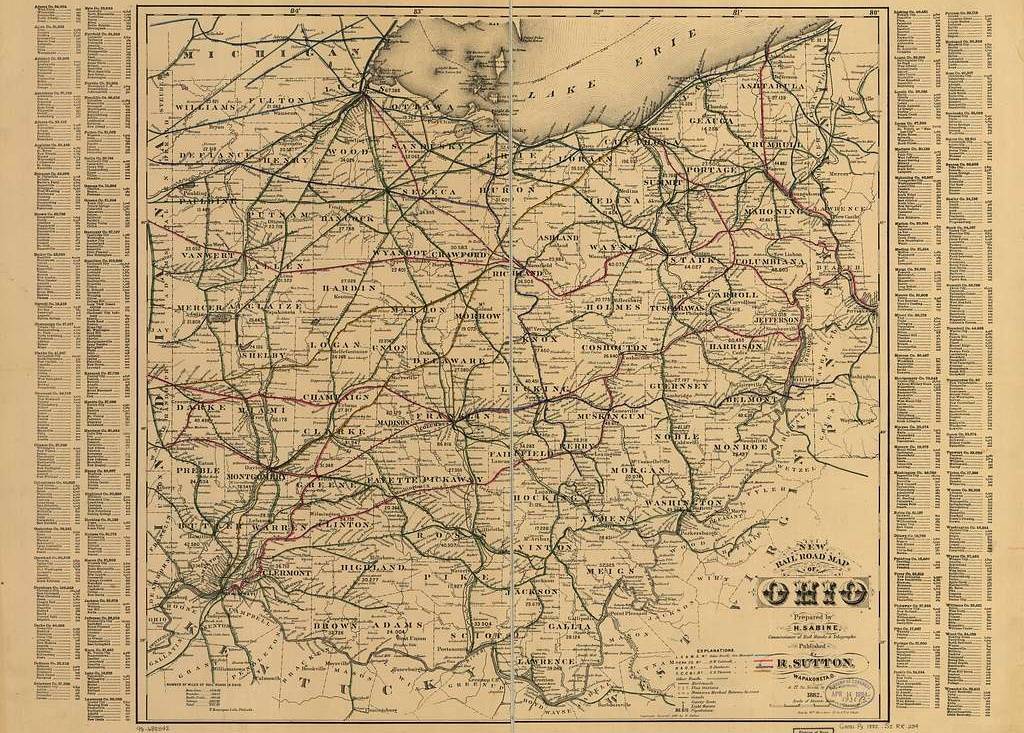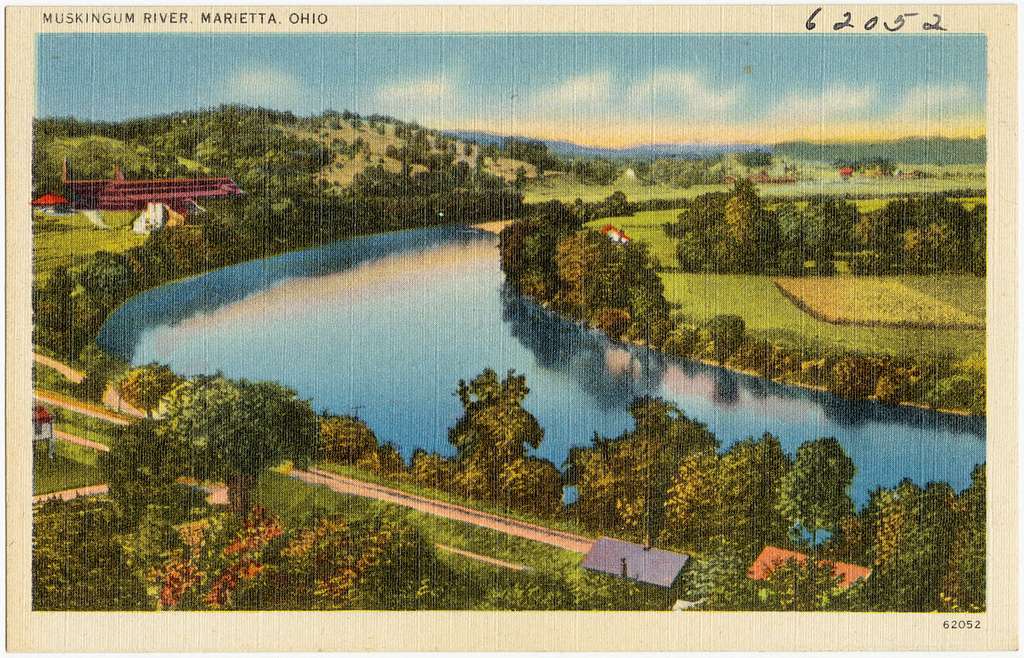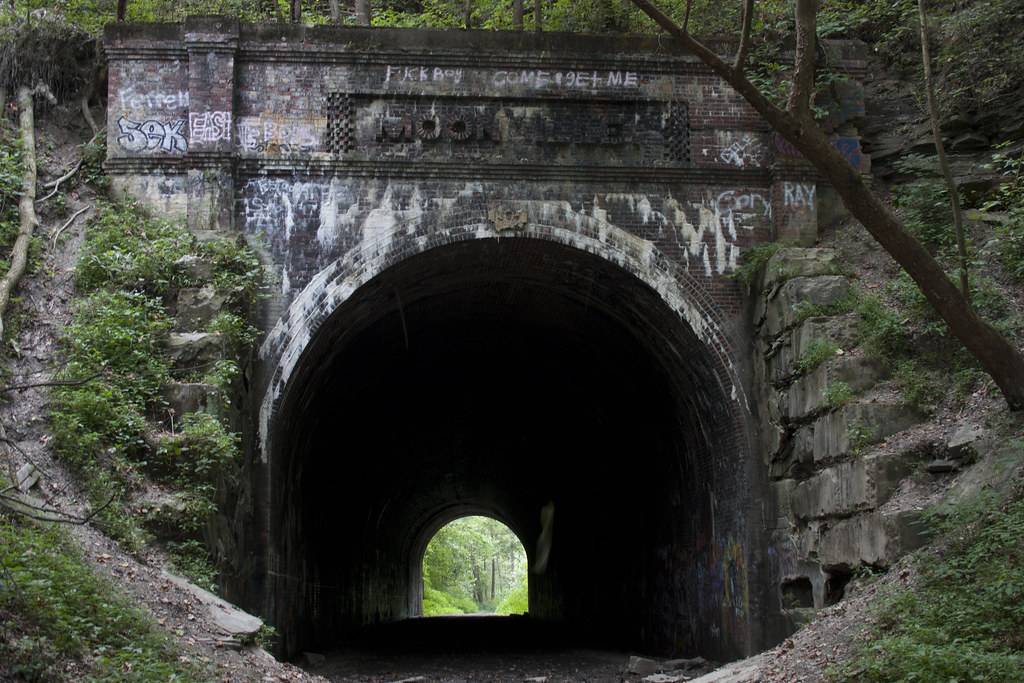Before Ohio became the 17th State, it had a fairly complicated history. You have the better part of two centuries where countries like the British Empire, France, and Spain tried to claim ownership, even though the native population had clearly been here long before them. You also had a number of settlers from other places showing up and seeking the good life, just wanting a little area to call home.
Even though the War of American Independance changed, well, close to everything – the region still had a few more years of being a hot mess, before European settlers finally set foot on Ohio soil and building villages, towns, and cities. History likes to focus on the settlers coming down The Ohio River, although others arrived via the great lakes.
Most history texts like to claim that the town of Marietta was the first Ohio settlement. If you’ve read my previous post, you’ll know that Marietta was settled in 1788 because of the efforts of The Ohio Company of Associates, which had been the first to buy land from the new federal government. It is also, currently, the oldest city in Ohio.
But, were they really the first? The short answer is … “Um, no.”
1772 – Schoenbrunn, Gnadenhutten, and Lichtenau Villages
David Zeisberger was born in 1721 in a place called Zauchtenthal, Moravia (today, that’s Suchdol nad Odrou in the Czech Republic) but, as a child, he and his family relocated first to the Moravian Christian community of Herrnhut. There he started his Christian education, which is where he remained until he had completed school, after which he joined his family in the Colony of Georgia. He and his family were part of a group calling themselves the United Brethren who were active in the Savannah area, a group devoted to converting the nearby Muscogee natives to Christianity.
Before long, he traveled to Pennsylvania to help start a Moravian community near Bethlehem, Pennsylvania. Later, he would become active in a variety of areas throughout New York and Pennsylvania, and into lands that would eventually become Ohio and Michigan.
In 1772, he helped create two Moravian communities called Gnadenhutten (German for House of Grace) and Schoenbrunn (German for Beautiful Spring). It was in the village of Schoenbrunn that some believe the first school was created in what would become Ohio, as well as developing the first “Civil Code” …
Native residents of Schoenbrunn were expected to not only uphold strict Christian traditions but were also barred from participating in any of their tribal customs.
The village of Schoenbrunn only thrived for about five years before the residents fled. The natives in the area were being targeted by the British, as well as the Frontiersmen who each wanted something different, and the mission at Schoenbrunn was caught in the middle. When the townsfolk fled, it is believed they burnt their meeting hall to the ground so that neither side could make use of it in the future.
The village of Gnadenhutten was also founded in 1772 (also influenced by Zeisberger). Legend has it that on July 4, 1773 a baby boy was born to the Roth family, the first european child born in what would become Ohio. The community here prospered for several years, until the American Patriots began forcing the native tribes into the northwestern regions of the Ohio Country. With Zeisberger arrested and being held at Fort Detroit, Patriots began rounding up all natives, including the residents of Gnadenhutten, who the Patriots claimed were acting as spies for the British. The women and children were brought into the snow where they were raped before being murdered while the rest of the community was held in the community center, singing Christian psalms and saying prayers. Soon, they would be executed, too.
In 1889, president Theodore Roosevelt would call the Gnadenhutten Massacre a “stain on frontier character that the lapse of time cannot wash away”
A third Moravian community was founded a few years later and named Lichtenau (German for “Meadow of Light”). Just as the other two communities had been, this community also met with a violent end at the hand of Patriot Soldiers who, rather than seek out the tribes responsible for various acts of violence against them, seemed to want to take revenge on any native population, guilty or not.
1788 – Adelphia aka Marietta
Today, Marietta is said to be the oldest city in Ohio and lists its founding date as April 7, 1788. The city had, for a short time, been known as Adelphia before being renamed to Marietta in honor of the French Queen (Marie Antoinette, perhaps you’ve heard of her).
It was here that The Ohio Company of Associates first set up shop in Ohio, selling plots of land to settlers, mostly from the New England area, but drawing some in from various parts of Kentucky and Virginia.
The city quickly became known for its agriculture, large farms, and apple orchards, and as the first Ohio town along the Ohio River, it became a hot spot for all sorts of consumer goods.
Today, Marietta continues to embrace its historic past. The historic district pays a modern homage to its Victorian roots. There are numerous historical buildings that have been restored, as well as a few museums worth checking out.
1788 – Losantiville aka Cincinnati
In the early 1980’s a gentleman named Benjamin Stites was traveling down the Ohio River when he lost a few horses to some native thieves. His initial response was to head north in search of his animals, and it was while he was doing this that he saw the fertile lands, ripe with possibilities. When he returned home, he spoke with his friend John Cleves Symmes, who wound up forming The Miami Company, which like The Ohio Company of Associates wanted to purchase tracts of land that could be sold off to settlers. While Symmes at first wanted to purchase more land, all they could afford was a smaller tract of land, north of The Ohio River, between the Little Miami River and the Greater Miami River, and north about twenty-five miles.
The Symmes Purchase, as it was known to be called, had a few sets of problems. First off, the survey was off in many ways, relying on magnetic north as opposed to true north, as well as a few further errors caused by sheer sloppiness (or, inexperience). His business dealings (the selling of this land to settlers) was likewise fraught with issues. There are numerous accounts of Symmes selling the same land to more than one person, or selling land he did not actually own (which resulted in his customers effectively becoming squatters).
On November 18, 1788 Benjamin Styles, along with a group of 26 others, purchased some of this land about a mile west of the Little Miami and created a settlement they called Columbia. The settlement quickly began to grow, but life here was rough for them. They were able to build a number of cabins using wood from their flatboats, and hunting and fishing gave them barely enough food to eat. They were also able to make a type of flour from the Bear Grass growing in the region. They still needed to trade goods being shipped down the Ohio River from Pittsburg.
On December 28, 1788, eleven families purchased land a little further down the Ohio River (near where the Licking River meets the Ohio, but on the north side of the river) which they named Losantisville. This name was completely named up word, made up from several foreign languages that was supposed to mean City Opposite the Mouth of the Licking River.
The city was laid out in the following years, and thirty lots were given to people so the new settlement would grow. Like the settlement of Columbia, they got their food from hunting and fishing, as well as growing crops like corn, beans, squash, pumpkins, and cucumbers. Before long, the settlement featured both a tavern as well as a Ferry service carrying passengers across The Ohio River.
The one thing Losantiville did not have – laws. Or, a police force to enforce them. In 1790 the town named William McMillan as their first Justice of the Peace.
In order to help settlers, Fort Washington was built nearby. It housed a number of soldiers, which in part helped Losantiville’s population to grow as far as 700 by 1790.
Symmes himself tried to create a third settlement, closer to the Greater Miami River which he planned on naming after himself but ultimately named North Bend. This settlement offered twenty-four plots of land for sale. Early settlers struggled to survive, and with resources few and far between, North Bend never fared nearly as well as the other settlements.
In 1790, Arthur St. Clair was the Governor of the Northwestern Territory. He was also, we must note, the president of a group called The Society of the Cincinnati, a fraternal organization with the goal of trying to commemorate the American Revolutionary War. When St. Clair saw the opportunity to change the name of Losantisville, he couldn’t resist – and we’re pretty sure you can guess what he started to call it.
As the settlement of Cincinnati grew from settlement into a city, it soon incorporated the Columbia area. By 1810, Cincinnati had a population of roughly 2,500 individuals. By 1820, that number had grown to 9,600 and the numbers continued to climb, exceeding 500,000 by the 1850s. (I suppose it’s important to note that the number refers to the City itself, and not the surrounding metropolitan area.)
1796 Chillicothe (and the other Chillicothes)
There has been a place in what we now call Ohio called Chillicothe since … well, we’re not quite sure. The word “Chillicothe” comes from a word used by the indigenous Shawnee to note the place where their tribal leader resides. In their language, it means something along the lines of “principal town”. Shawnee tradition says that its tribal leaders must all hail from one specific tribe, and when the current leader dies, he gets replaced and whatever location he resides in is then referred to as “Chillicothe” until he passes and another leader is chosen – the cycle continues. So, technically speaking – a place called Chillicothe has existed in Ohio well before the Europeans first set eyes on this land and said to themselves, “this looks like a nice area.”
As for the city we, today, call Chillicothe, it was founded in 1796. And as far as we can tell, not a single Shawnee tribal leader has ever resided there. (But, what do we know?)
The city’s history begins with a guy named Nathaniel Massie. He was one of the people charged with surveying various parts of the Ohio Country so it was hardly a surprise when he began purchasing various plots of land, including one along the Scioto River, where Massie created a small settlement.
In 1800, the Indiana Territory broke off from the Northwest Territory. By then Chillicothe had been incorporated with Ross County and had become the county seat. Two years later, when Ohio began the process of becoming a full-fledged state, Chillicothe was chosen to be the new capital. (Eventually, though, the capitol would change to Columbus.)
When Ohio became a state, it was deemed a “Free State” … or, a state where slavery was illegal. This fact caused a number of blacks, including former or escaped slaves, to move into the state. One community that seemed to welcome them was Chillicothe and soon it became an important stop on The Underground Railroad.
1795 – Cleaveland aka Cleveland
Today, Cleveland might be the largest city on Lake Erie, but once upon a time there wasn’t anything there. The Connecticut Land Company was the one tasked with surveying that part of the newly acquired land. This survey was led by one of the company’s principal investors: Moses Cleaveland. While Cleaveland was busy planning the settlement, its first resident was actually one Lorenzo Carter, who built himself a cabin on the banks of the Cuyahoga River. The settlement was incorporated as a village on December 23, 1814.
Cleaveland’s position on Lake Erie did give it a few advantages for the budding nation. It quickly became an important supply shop, especially during The Battle of Lake Erie during the War of 1812. It also proved to be a vital stop while the nation expanded through Indiana, Illinois, and Michigan. (Traveling from Lake Erie to the Atlantic Ocean wasn’t as easy as following the waters down the St. Lawrence River, as anyone who has seen a picture of Niagra Falls could attest.) Later, when canals were built crossing the state of Ohio from Lake Erie to The Ohio River, this opened Cleveland to even further importance.
Rumor has it that Cleaveland officially changed its name to Cleveland because the government at the time was trying to save some money, as if printing one less letter (an “a”) on official plates and correspondances was going to save them a ton of money. That’s a good story (legend) but the truth is that even many of the men in Moses Cleaveland’s company spelled the name without the “a”. Therefore, even in the early days, people were spelling the name of the town both ways. Eventually, the “a” got dropped for good and has been officially “Cleveland” ever since.
1796 – Dayton
The portion of the state that would eventually include the city of Dayton was first surveyed and plotted by Israel Ludlow who had recently finished doing the same in the Cincinnati area. The town would be named for Jonathan Dayton, founding father (and the youngest person to have signed The Declaration of Independence.
The first year was one of rapid growth. The city finished the year with 40 cabins having been built for housing. Unfortunately, The War of 1812 put a damper on Dayton’s growth. But, after the war, growth continued and the city began to prosper. Soon, Dayton would be among the fastest growing and richest cities in the state of Ohio.
Dayton’s success stemmed from both agriculture and industry. It would be here that many early advances in industry were made. For example, The National Cash Register Company, founded in 1884, would help revolutionize the retail industry. Perhaps the most famous of all, Dayton would go on to be called The Birthplace of Aviation, being the home of Orville and Wilbur Wright.
Dig Deeper!
- Schoenbrunn Village – Ohio History Connection
- Schoenbrunn Village – Touring Ohio
- Gnadenhutten massacre – Wikipedia
- Marietta, Ohio – Wikipedia
- City of Marietta, Ohio Official Website
- City of Chillicothe, Ohio Official Website



